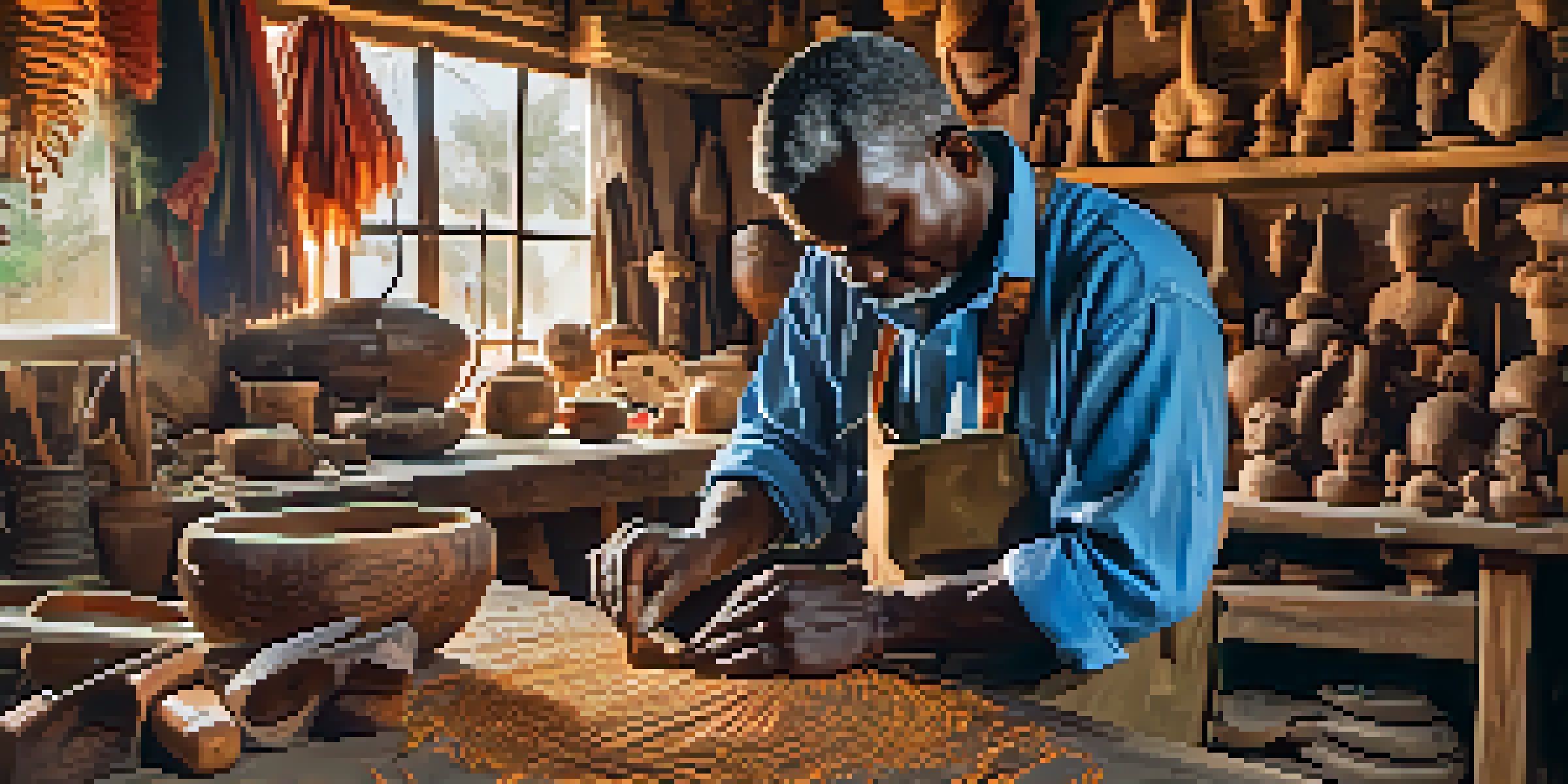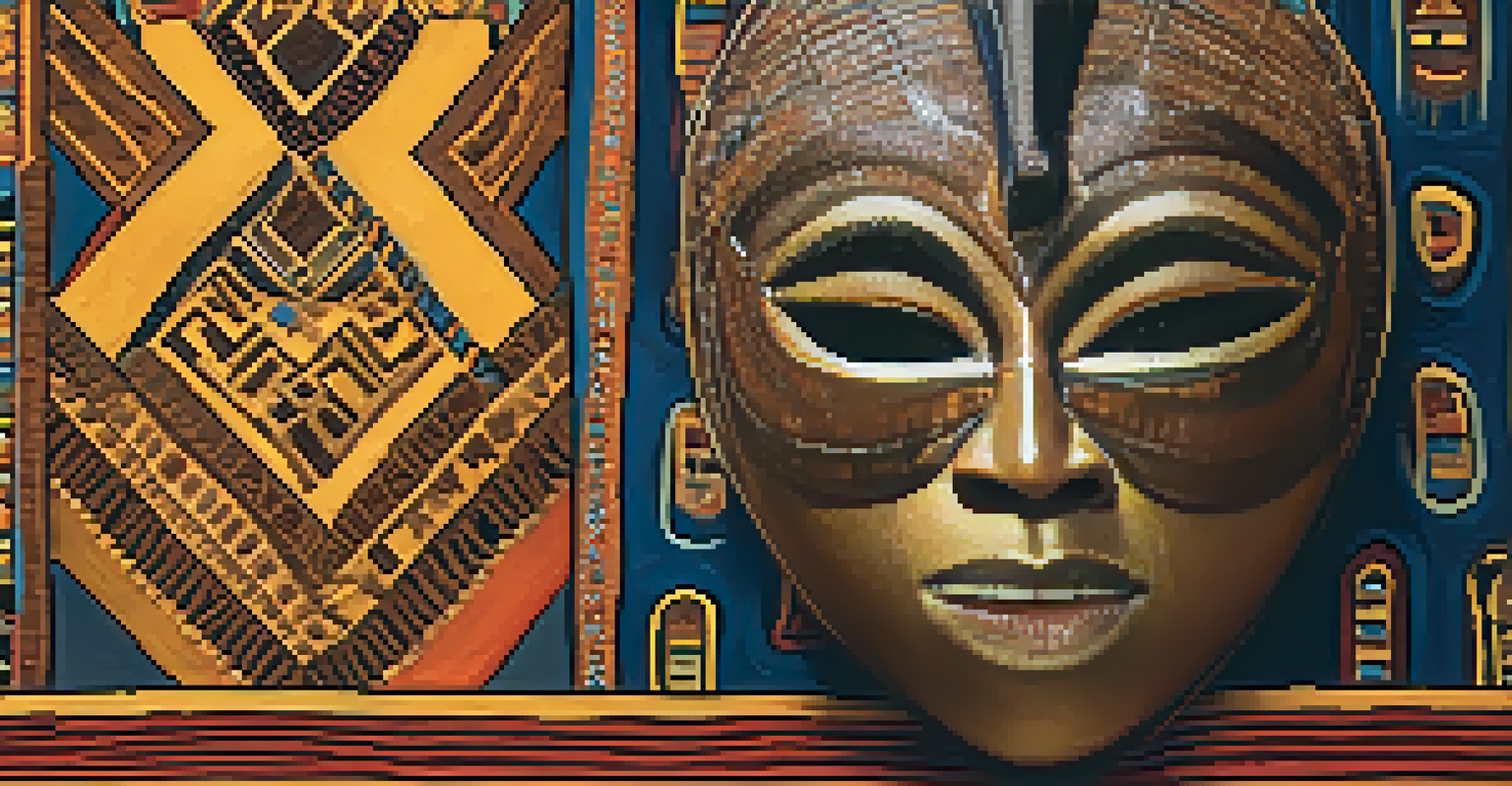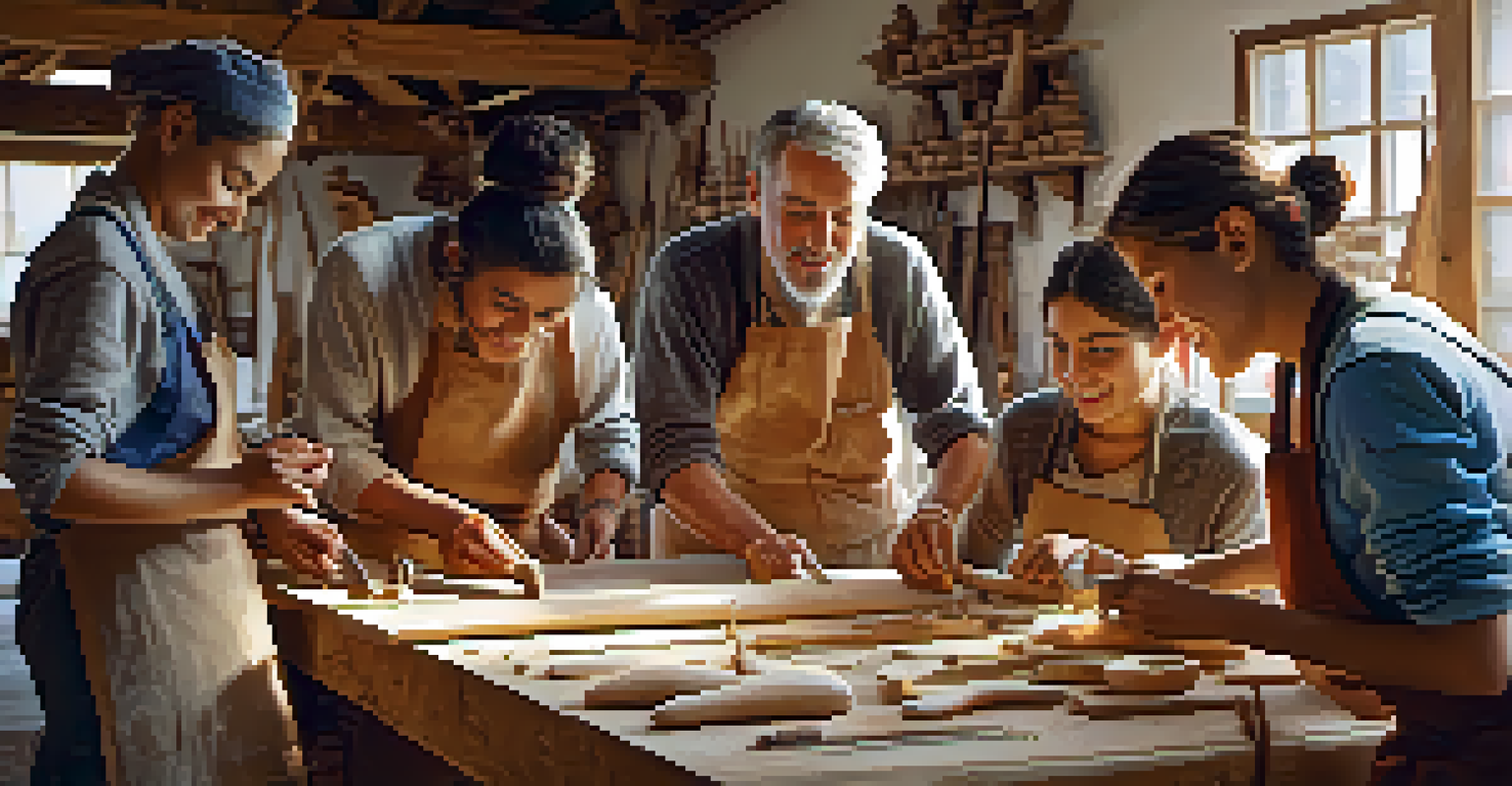The Role of Carving in African Art and Culture

Understanding Carving as a Cultural Expression
Carving plays a vital role in African art, serving as a medium of storytelling and cultural expression. Each carved piece often reflects the values, beliefs, and traditions of the community it originates from. For instance, masks carved for ceremonies can symbolize ancestral spirits, embodying the connection between the living and the spiritual realm.
Art is the most beautiful of all lies; it is the expression of the soul of a culture.
The intricacies of each carving reveal the skill and creativity of the artist, often passed down through generations. This transmission of knowledge not only preserves techniques but also strengthens community bonds. Artists become custodians of their cultural heritage, ensuring that stories and traditions endure.
Moreover, carving is often a communal activity, bringing together artisans and community members. This collaboration fosters a sense of unity and shared purpose, reinforcing the idea that art is not just an individual endeavor but a collective expression of identity.
Materials and Techniques Used in African Carving
African carvers utilize a variety of materials, such as wood, bone, ivory, and stone, each chosen for its significance and availability. For example, hardwoods like mahogany and ebony are prized for their durability and ability to hold intricate designs. The choice of material often reflects local resources and cultural preferences.

Techniques can vary widely across different regions and cultures, from the use of simple hand tools to more complex carving methods. Some artists employ chiseling, while others may use a combination of carving and painting to enhance their work. This diversity in technique not only showcases individual creativity but also highlights regional traditions.
Carving as Cultural Storytelling
Carving serves as a vital medium for expressing cultural values and traditions, often acting as a bridge between communities and their ancestral stories.
Additionally, the process of carving is often steeped in rituals and beliefs. Before beginning a piece, artists may perform ceremonies to bless their tools and materials, emphasizing the spiritual aspect of their work. This connection to the spiritual world further enriches the meaning behind each piece.
Symbolism in African Carvings
Symbolism is a crucial element in African carving, where each design can carry profound meanings. Common motifs may represent fertility, strength, or protection, and are often influenced by the community's history and environment. For instance, a carving featuring a lion might symbolize bravery and leadership.
The purpose of art is not a rarified, intellectual distillate; it is life, intensified, and it is life, made better.
These symbols serve not only as decorative elements but also as reminders of cultural narratives and values. When displayed, they convey messages about identity and heritage to both the community and visitors. This storytelling aspect makes every carved piece a conversation starter, inviting viewers to explore its deeper meanings.
Furthermore, the interpretation of these symbols can vary among different cultures, adding layers of complexity to African art. This richness encourages cross-cultural dialogue and understanding, allowing people from diverse backgrounds to connect through shared stories and experiences.
Carving in Rituals and Ceremonies
Carving is often integral to rituals and ceremonies within African cultures, highlighting its significance beyond mere aesthetics. For example, ceremonial masks are crafted for dances and rituals, embodying spirits or ancestors that guide the community. These events create a powerful connection between art and spirituality.
In many cultures, the act of creating a carving can also be a ritual in itself. Artists might engage in prayer or meditation to channel their intentions into the piece, adding a layer of spiritual significance. This process transforms the carving into a sacred object that holds cultural and spiritual weight.
Symbolism Enriches Carving Art
Each carving embodies profound symbols that convey community narratives, inviting deeper exploration of cultural identity and shared experiences.
Moreover, these ceremonial carvings often serve as focal points during celebrations or important life events, such as marriages or funerals. They help to visually narrate the stories of a community, serving as tangible reminders of shared beliefs and practices.
The Influence of Modernity on Carving Practices
As African societies evolve, so too do the practices of carving. Modern influences, including globalization and the rise of digital media, have introduced new techniques and materials into traditional carving. While some artists embrace these changes, others strive to maintain traditional methods, leading to a dynamic fusion of the old and new.
Social media platforms have also provided a stage for contemporary African carvers to showcase their work to a global audience. This exposure can lead to increased appreciation and demand for traditional pieces, helping to sustain the livelihoods of local artisans. However, it also raises questions about authenticity and the commercialization of cultural art.
Despite these challenges, many artists continue to draw inspiration from their heritage, blending traditional symbols with modern themes. This evolution allows for the preservation of cultural identity while also appealing to contemporary audiences, ensuring that African carving remains relevant in today's world.
Preservation of Traditional Carving Techniques
Preserving traditional carving techniques is essential for maintaining cultural heritage in Africa. Many communities actively work to pass down skills through mentorship programs, where experienced artisans teach younger generations. This hands-on approach not only keeps the art form alive but also fosters a sense of pride in cultural identity.
Additionally, organizations and cultural institutions are stepping in to document and support traditional carving practices. By creating platforms for artists to share their work, these initiatives help raise awareness about the importance of preserving these techniques. They often organize workshops and exhibitions, further promoting the art form.
Economic Value of Carving
Carving significantly boosts local economies by providing income for artisans and supporting related businesses through tourism and cultural appreciation.
However, challenges remain, such as the loss of access to traditional materials and the influence of mass-produced art. To combat this, artisans are innovating by using sustainable practices and finding new ways to incorporate traditional elements into contemporary designs, ensuring the longevity of their craft.
The Economic Impact of Carving in African Communities
Carving significantly contributes to the economies of many African communities, providing income and employment opportunities for artisans. By creating unique pieces, artists can attract both local and international buyers, boosting their financial stability. This economic impact is vital, especially in areas with limited job opportunities.
Moreover, the sale of carved items often supports local businesses and tourism, creating a ripple effect within the community. Visitors seeking authentic cultural experiences are drawn to traditional crafts, leading to increased revenue for artisans and related businesses. This relationship between art and economy underscores the importance of cultural preservation.

Additionally, as communities recognize the value of their artistic heritage, there is a growing movement to promote and protect traditional carving. This not only enhances local pride but also encourages sustainable practices that benefit both the community and the environment.